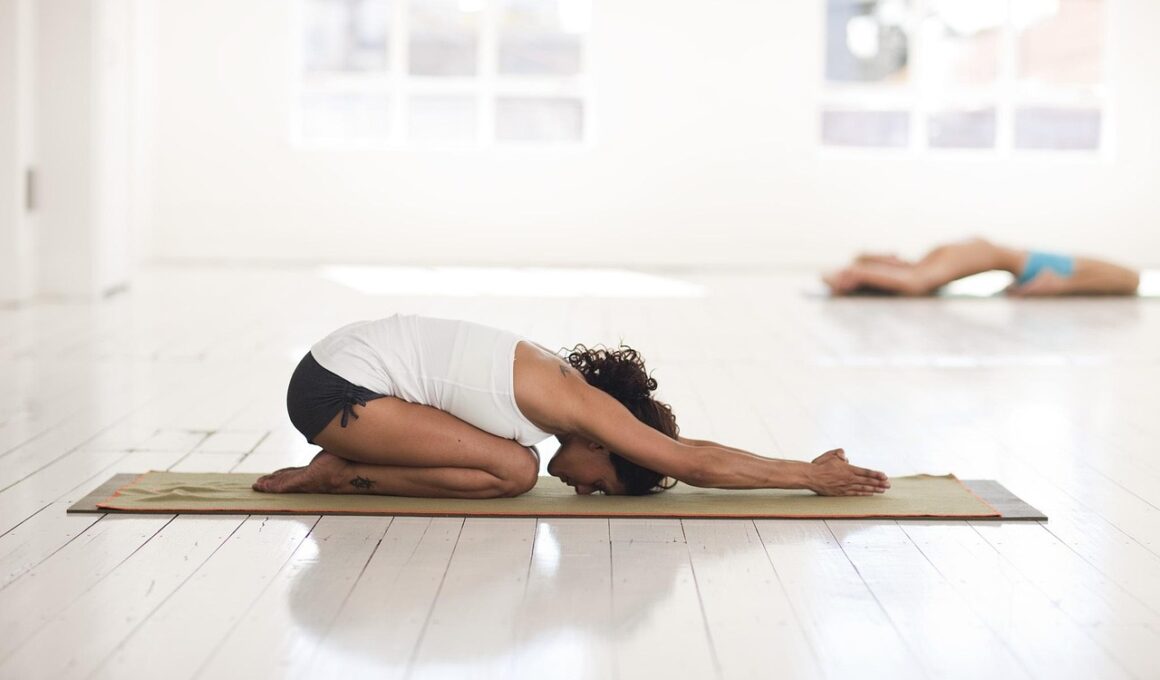Assessment of Lower Body Flexibility: Best Practices
Flexibility not only enhances athletic performance but also minimizes the risk of injuries. Assessing the lower body flexibility can greatly improve your workout regimen. There are several methods you can use to evaluate this crucial aspect of physical fitness. One popular method includes the sit-and-reach test, where individuals attempt to reach forward while seated, testing hamstrings and lower back flexibility. Additionally, the standing quadriceps stretch evaluates the flexibility in the quadricep muscle group. Incorporating these methods allows trainers to plan targeted flexibility routines for better results. Always ensure to warm up before assessments to prevent injuries. Techniques vary based on demographic and individual fitness levels. Standard assessments benefit from consistency in conditions, making it easier to track progress over time. Regular testing also provides invaluable feedback on flexibility improvements. Results from these tests should inform decision-making for future workouts. Furthermore, employing a combination of subjective and objective measurements will yield the most accurate assessments of flexibility. This approach increases adherence to fitness programs by demonstrating tangible progress in flexibility levels. Keeping a record of these assessments helps in adjusting training plans as individuals progress.
Warm-up routines play a pivotal role in preparing the body for flexibility testing. Ensuring muscles are warm reduces injury risks and maximizes test efficiency. Common warm-up exercises include dynamic stretches focused on the legs and hips, which effectively increase blood flow to the lower body. Another effective approach is performing light cardio activities such as jogging or skipping. Gradually increasing heart rate and muscle temperature optimizes performance during flexibility assessments. A well-structured warm-up routine invigorates the individual and enhances overall mobility. Once the muscles are adequately prepared, transitioning into flexibility tests becomes smoother. Various stretching techniques can be utilized in preparation, such as active or passive stretches. Active stretches engage targeted muscle groups, whereas passive stretches rely on an external force to assist. Individuals should incorporate both methods into their workout routine for a well-rounded approach to flexibility training. When testing lower body flexibility, observing proper form is of utmost importance. Maintain alignment and posture while performing each test. Monitoring breathing techniques also aids in fostering relaxation and maximizing effectiveness. Practicing these principles results in reliable evaluations of flexibility and contributes to accomplishing physical fitness goals.
Common Flexibility Testing Methods
In this section, we will explore common flexibility testing methods suitable for assessing lower body flexibility. The sit-and-reach test is widely utilized, primarily targeting the hamstrings and lower back. Participants sit on the ground with legs extended and reach toward their toes, measuring how far they can stretch. Results are typically recorded in centimeters or inches, providing useful benchmarks. Another method includes the standing toe touch, where individuals stand and bend forward to touch their toes. This test evaluates overall hamstring and lower back flexibility. Additionally, the butterfly stretch is another effective method for gauging hip flexibility. During this test, participants sit with the soles of their feet together and push their knees toward the ground. Assessment through visual observation can also occur when participants perform deep squats to evaluate hip and ankle flexibility. These methods effectively gauge flexibility levels through various ranges of motion. They can also provide insights into potential imbalances or areas requiring improvement. Regular testing using these methods allows individuals to track progress effectively, maintaining their motivation and commitment to flexibility improvement. Adjust training programs accordingly based on results to foster continued development.
Prioritizing lower body flexibility presents numerous benefits, particularly in enhancing athletic performance. Improved flexibility increases range of motion, enabling athletes to execute movements effectively. Increased mobility results in better coordination, allowing for more proficient execution of sport-specific skills. Flexible muscles and joints tend to recover faster from strenuous activities, subsequently reducing recovery time and enhancing performance longevity. Furthermore, improved lower body flexibility plays a crucial role in injury prevention. Muscles and joints that can move freely are less prone to strains and sprains. Developing flexibility promotes a greater ability to absorb the impact during physical activities. As lower body flexibility improves, overall athleticism tends to increase, contributing to higher levels of competition. Additionally, flexibility training benefits everyday activities, like climbing stairs or bending to pick up objects. This translates into better quality of life and physical health. Ultimately, practitioners seeking to enhance their lower body flexibility must commit to regular assessment and target-specific training routines. Consistency is key in achieving and maintaining improved flexibility levels. Cultivating awareness around individual flexibility needs informs the design of personalized fitness programs for optimal results. Engaging in flexibility assessments keeps the goal in sight while fostering accountability throughout the process.
Conclusion: Why Flexibility Testing Matters
Flexibility assessments pave the way for tailored fitness programs that optimize performance and safety. By understanding individual flexibility levels, participants can identify strengths and weaknesses. This information is essential for crafting a balanced training regimen that includes both strength and flexibility components. Flexibility testing should form an integral part of any fitness assessment or training plan. It not only reveals areas needing improvement but also encompasses preventative measures against injury. Moreover, measurable flexibility gains correlate with enhanced athletic performance in various sports. Such information equips individuals with the motivation to push further in their fitness journeys. Keeping a detailed log of flexibility assessments enables users to visualize their progress over time. Realizing tangible improvements fosters consistency in training and enhances overall fitness commitment. Trainers and athletes alike can benefit from implementing these assessments into their routines. Continuous testing encourages a practice of self-awareness and personal growth. Understanding how flexibility influences daily life is crucial for maintaining holistic wellbeing. Ultimately, embracing a culture of flexibility testing lays the groundwork for lasting physical health benefits, improving athletic performance, and enhancing overall mobility in everyday situations.
In conclusion, lower body flexibility is of paramount importance for both athletes and individuals aiming for improved overall fitness. The methods of flexibility testing discussed serve as valuable tools for assessing this vital aspect of physical health. Each individual has unique flexibility needs, making personalized assessments essential for achieving optimal results. Incorporating warm-up routines effectively prepares the body for testing sessions, while understanding common flexibility testing methods ensures accurate evaluations. As consistency plays a critical role in flexibility improvement, regular assessments facilitate ongoing commitment to personal fitness goals. Appropriate flexibility training not only enhances performance across various sports but also contributes to injury prevention and improved quality of life. Flexibility assessments grant valuable insights into muscle elasticity, joint mobility, and overall physical condition. Keeping detailed records allows individuals to track progress and adjust their training regimen according to their specific needs. This can contribute to sustainability in any fitness journey. Embracing the concept of flexibility testing fosters an environment of motivation and personal growth. By prioritizing lower body flexibility, practitioners can maximize effectiveness in fitness programs while enhancing their physical well-being.


